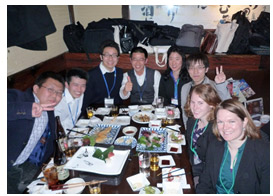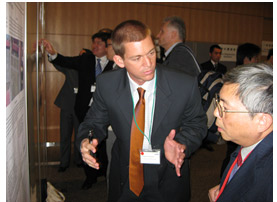oŨ
Home > oŨ > j [Y^[ > A Decade of CUEE-PEER Accomplishments
A Decade of CUEE-PEER Accomplishments
Professor Ross W. Boulanger (UCD) and
Professor Stephen A. Mahin (UCB; Director) of
Pacific Earthquake Engineering Research Center
 |
Japanese and PEER young researchers network during dinner after the 2009 CUEE Young Researcher Workshop in Tokyo. |
 |
PEER graduate student Patrick Wilson from the University of California, San Diego explains his research to a Japanese colleague during the poster session at the 2009 CUEE Annual Conference. |
The Center for Urban Earthquake Engineering (CUEE) at the Tokyo Institute of Technology, Japan and the Regents of the University of California on behalf of the Pacific Earthquake Engineering Research Center (PEER), U.S.A., signed a Memorandum of Understanding expressing their dedication to an international integration of our research and education activities in earthquake engineering almost a decade ago. That agreement strengthened existing bonds of cooperation between the CUEE and PEER Centers and produced a string of accomplishments which have made a lasting impact on our communities and profession.
Perhaps the most unique and signature accomplishment of joint CUEE-PEER activities has been the mentoring and development of a generation of young researchers with strong ties to their peers in the US, Japan, and other countries. The annual Young Researchers Workshop was particularly central to this effort, with its focus on bringing young researchers from various countries together to exchange research findings in both formal and informal settings. Over 50 young researchers from nine different universities within PEER were able to visit Japan and participate in these workshops, and post-event survey data show that these events were highly effective in broadening their perspectives, advancing their studies, and forging lasting networking connections. These ties made other exchanges between our young researchers all the more effective during research exchanges, meetings, and conferences.
Technical exchanges between CUEE and PEER research communities have contributed to major advances across our disciplines and been broadly beneficial outside our respective organizations as well. The value of CUEE-PEER connections was, perhaps, most visible following the 2011 M=9 Tohoku Earthquake when our members played lead roles in bringing together a broader set of Japanese and US researchers during reconnaissance efforts and post-reconnaissance research collaborations. CUEE-PEER members have also played major roles in bringing together researchers involved in large scale experimental studies as performed through NEES in the USA and at the Miki Shaking Table in Japan. These various connections, along with the highly successful annual international conferences hosted by CUEE and annual meetings hosted by PEER, have been effective in ensuring that the best research ideas and findings from our respective countries are more rapidly shared with each other and the world.
The future is bright for continued research and education exchanges between the members of CUEE and PEER precisely because the past decade has built a solid foundation of personal and technical connections between our respective communities. We expect to see continued technical exchanges and cooperation between our members, even if the current funding situations mean that certain events will be scaled back. It is our hope that the lasting friendships that these CUEE-PEER activities have established between our young researchers will be as valuable to their successes as they have been for the generation of researchers before them.
PEER congratulates CUEE on a wonderfully successful and impactful decade of accomplishments in addressing the problems that earthquakes pose for our urban areas.
